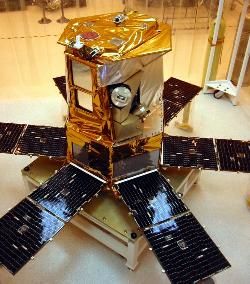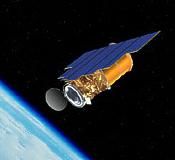
Home - Search - Browse - Alphabetic Index: 0- 1- 2- 3- 4- 5- 6- 7- 8- 9
A- B- C- D- E- F- G- H- I- J- K- L- M- N- O- P- Q- R- S- T- U- V- W- X- Y- Z
SORCE
 SORCE Credit: NASA |
AKA: Solstice. Status: Operational 2003. First Launch: 2003-01-25. Last Launch: 2003-01-25. Number: 1 . Gross mass: 315 kg (694 lb).
The Solar Radiation and Climate Experiment (SORCE) was a NASA-sponsored satellite mission that provided state-of-the-art measurements of incoming x-ray, ultraviolet, visible, near-infrared, and total solar radiation. The measurements provided by SORCE specifically addressed long-term climate change, natural variability and enhanced climate prediction, and atmospheric ozone and UV-B radiation.
SORCE measured the Sun's output with the use of state-of-the-art radiometers, spectrometers, photodiodes, detectors, and bolometers engineered into instruments mounted on a satellite observatory. Spectral measurements identified the irradiance of the Sun by characterizing the Sun's energy and emissions in the form of color that can then be translated into quantities and elements of matter. Data obtained by the SORCE experiment were to be used to model the Sun's output and to explain and predict the effect of the Sun's radiation on the Earth's atmosphere and climate.
The SORCE spacecraft was launched on a Pegasus XL launch vehicle to provide NASA's Earth Science Enterprise (ESE) with precise measurements of solar radiation. It was launched into a 645 km, 40 degree orbit and was operated by the Laboratory for Atmospheric and Space Physics (LASP) at the University of Colorado (CU) in Boulder, Colorado, USA. It would continue the precise measurements of total solar irradiance (TSI) that began with the ERB instrument in 1979 and has continued to the present with the ACRIM series of measurements. SORCE would also provide the measurements of the solar spectral irradiance from 1nm to 2000nm, accounting for 95% of the spectral contribution to TSI. SORCE carried four instruments including the Total Irradiance Monitor (TIM), Solar Stellar Irradiance Comparison Experiment (SOLSTICE), Spectral Irradiance Monitor (SIM), and the XUV Photometer System (XPS).
Spacecraft
The spacecraft for the SORCE mission was being provided by Orbital Sciences Corporation. It was tailored to accommodate SORCE mission requirements and the SORCE instruments.
The bus module of the spacecraft provided all of the on-orbit support required for the instrument suite to obtain the mission science data and transmit it to the ground for processing and distribution. The bus and the instrument module (IM) were developed and integrated separately at the Orbital and LASP facilities prior to their system level integration and environmental testing.
The SORCE satellite bus was based on Orbital's LEOStar-2 satellite platform and was customized to meet SORCE mission specific requirements. Engineers and scientists from NASA, LASP, and Orbital worked together throughout the design phase to optimize the hardware components and to maximize performance and reliability. The satellite structure was a robust, hexagonal modular unit.
Specifications
- Satellite Mass: 290kg
- Power: 348 Watts
- Communications: Redundant S-Band Transceivers
- Inertial Pointing: Slew Rate > 1 deg /sec
- Knowledge < 60 arcsec
- Solar Arrays: Fixed GaAs
- Redundancy: Nearly fully redundant
- Orbit: 645km, 40 deg inclination
- Mission Life: 5-year (6-year goal)
- Dimensions: 62" height, 45.5" diameter
- Launch Vehicle: Pegasus XL
The SORCE satellite used a 3-axis inertially stabilized, zero momentum design that was capable of precision pointing and attitude knowledge during science observations.
The satellite bus includes:
- S-Band communications, compatible with NASA's ground network.
- Science data storage with capacity for more than 24 hours of spacecraft data.
- Six solar array wings for power generation.
- Reaction wheels, star trackers, sun sensors, magnetometers and torque rods for attitude control.
-
Attitude Determination & Control:
- 3-axis inertially stabilized
- Solar pointed (day side)
- Stellar pointed (night side)
- accuracy: better than 60 arc-sec (pitch and yaw)
- knowledge: better than 36 arc-sec (pitch and yaw)
- stability: better than 1.0 arc-min/min (pitch and yaw)
- jitter: better than 20 arc-sec/sec (pitch and yaw)
- Slew rate: > 1 deg /sec
- S-Band
- uplink 2 kbps
- downlink 1.5 Mbps
- 4kbps TDRSS compatible
- LEO-T ground stations at Wallops Island, Virginia and Santiago, Chile
- Two passes per day
- Data storage: 1024 Mbit
The spacecraft provided radio communications for space-to-ground and space-to-space interfaces. The subsystem used dual transceivers and a pair of omni-directional antennas and was completely redundant. SORCE was compatible with the NASA Space/Ground Network and the TDRSS system, which was especially important during early orbit checkout.
The SORCE Command and Data Handling (C&DH) subsystem controlled all aspects of the bus operations. Commands from the ground were received within the C&DH system by way of the radio frequency (RF) subsystem, and acted upon by the spacecraft computer, or passed directly to the IM microprocessor for instrument operations. Data collected during the spacecraft operations were stored and processed through the RF subsystem back to the ground.
The SORCE satellite bus used both off-the-shelf components that were manufactured around the world as well as customized components developed in Orbital's manufacturing facility. The spacecraft was integrated and tested for the rigors of space flight in Orbital's clean room and environmental test facility in Dulles, Virginia. SORCE took advantage of Orbital's proven methodologies that ensured rapid development and delivery of a highly reliable spacecraft. SORCE was a manifestation of Orbital's 20-year experience in the design, manufacture, and launch of quality satellites.
More at: SORCE.
Family: Astronomy, Solar. Country: USA. Launch Vehicles: Pegasus, Pegasus XL. Launch Sites: Mayport DZ. Bibliography: 2, 554, 6896, 13118, 4070, 4071, 4072, 4073, 4074, 4075.
 | Leostar / Orbview 3 |
 | SORCE Credit: Manufacturer Image |
2003 January 25 - . 20:13 GMT - . Launch Site: Cape Canaveral. Launch Complex: Mayport DZ. Launch Pad: 29.0 N x 78.5 W. Launch Platform: L-1011. LV Family: Pegasus. Launch Vehicle: Pegasus XL.
- SORCE - . Payload: Solstice/SAVE. Mass: 268 kg (590 lb). Nation: USA. Agency: NASA. Manufacturer: OSC. Class: Astronomy. Type: Solar satellite. Spacecraft Bus: LEOStar-2. Spacecraft: SORCE. USAF Sat Cat: 27651 . COSPAR: 2003-004A. Apogee: 657 km (408 mi). Perigee: 617 km (384 mi). Inclination: 39.99 deg. Period: 97.31 min. Solar irradiance monitoring, climatology mission. Launch delayed from December 1 and 13, 2002. Air dropped in Mayport DZ..
Back to top of page
Home - Search - Browse - Alphabetic Index: 0- 1- 2- 3- 4- 5- 6- 7- 8- 9
A- B- C- D- E- F- G- H- I- J- K- L- M- N- O- P- Q- R- S- T- U- V- W- X- Y- Z
© 1997-2019 Mark Wade - Contact
© / Conditions for Use